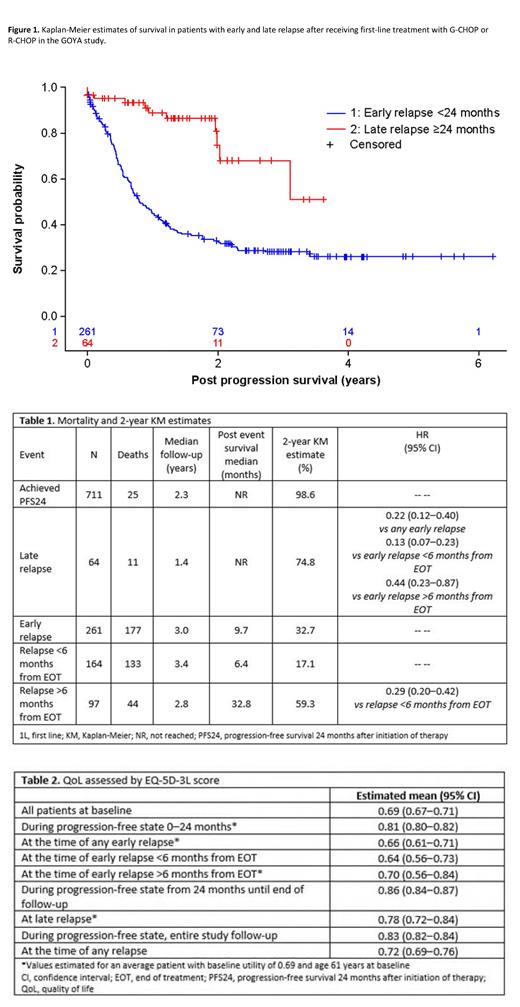Abstract
Background: Most patients (pts) with diffuse large B-cell lymphoma (DLBCL) receiving first-line (1L) rituximab plus CHOP (R-CHOP) have similar mortality to the general population (gen popn) if they are progression-free at 24 months (PFS24; Maurer et al. Ann Oncol 2018). Characterization of quality of life (QoL) and clinical outcomes may enable more patient-relevant treatment decisions. Using GOYA trial data (NCT01287741) comparing obinutuzumab (G) + CHOP (G-CHOP) with R-CHOP, we present an exploratory analysis of 1L DLBCL pts with IPI 2-5 and assess overall survival (OS) and QoL relative to the gen popn. GOYA was not included in the previous PFS24 analysis by Maurer et al.
Methods: We used data from both GOYA treatment arms to identify pts with IPI 2-5 DLBCL (n=1132 pts, intent-to-treat popn). Post-progression survival (PPS) in DLBCL is independent of prior treatment (Coiffier et al. Blood 2010) and as PFS was similar between treatment arms in GOYA, we assumed similar mortality after PFS24. Clinical outcomes were PFS24 (progression-free ≥24 months [m] from treatment start); early relapse (disease progression [PD]<24m from treatment start); late relapse (PD after PFS24). Outcomes for study pts vs gen popn were evaluated using standardized mortality ratios (SMR; deaths in study pts relative to expected deaths in gen popn matched by age, sex, country, and calendar time-at-risk). Expected deaths were derived using the Human Mortality Database, which provides detailed mortality and population data by country and can be used to estimate the background mortality during the observation period.
Post-relapse survival in pts with early vs late relapse was assessed using Kaplan-Meier (KM) estimates and Cox regression. QoL was assessed using EQ-5D-3L and UK-based tariffs (Dolan. Med Care 1997); association between QoL and clinical outcomes used a linear mixed-effects model. The proportion of pts with PFS24 reporting QoL problems at baseline and after 24m was compared with age- and country-matched values in the gen popn (Janssen et al. Springer 2014). Data cut-off was Jan 2018 (GOYA final data cut); overall median follow-up was 48m.
Results: In the overall IPI 2-5 population, mean age at treatment initiation was 61 yrs. 711 pts reached PFS24, of whom 64 experienced a late relapse (Table 1). Early relapse was experienced by 261 pts, of whom 164 were <6 months from end of treatment (EOT). OS following PFS24 was 98.6% at 2 years (including patients who later relapsed). 2-year PPS was 35.7% for pts with early relapse vs 74.8% for patients with late relapse (Figure 1.)
Mortality following PFS24 was 72% of the matched gen popn (SMR 0.72; not significant: 95% CI 0.44-1.11). Mortality following relapse in pts who experienced early relapse was over 33 times higher than expected in the matched gen popn (SMR 33.57, 95% CI 27.69-40.33). However, risk of death following late relapse was reduced by 78% compared with risk following early relapse (HR 0.22 95 CI% 0.12-0.40), and mortality following late relapse was significantly higher than in the matched gen popn (SMR 6.7, 95% CI 3.05-12.67). Mean QoL utility score at baseline was 0.69 for all pts. After pts reached PFS24, estimated mean utility score was 0.86 (95% CI 0.84-0.87) and worsened by -0.07 (95% CI -0.14 to -0.01) at time of subsequent relapse. For early-relapsing pts, the worsening in utility was -0.15 (95% CI -0.20 to -0.10) compared with those still progression-free (Table 2).
Among all PFS24 pts at baseline, problems were reported with mobility (28.1%), self-care (12.6%), usual activities (41.8%), pain/discomfort (62.7%), and anxiety/depression (48.8%); these rates were 2.2-4.7 times higher than the gen popn based on age- and country-standardized values. Compared with the gen popn, after pts reached PFS24, pain/discomfort was 10% lower, whereas anxiety/depression was 34% higher and other QoL items were approximately 20% higher.
Conclusions: Most of the clinical course of 1L DLBCL occurred ≤2 years after start of treatment. In DLBCL pts with IPI 2-5 achieving PFS24, mortality was similar to the gen popn, and with the exception of mental health metrics, QoL scores were also similar to the gen popn. Late relapse (≥2 yrs) was associated with better post-relapse survival than early relapse (<2 yrs); however, this was inferior to the gen popn. Health state utilities improved whilst patients were relapse-free but the decline in QoL after early relapse was worse than after late relapse.
Launonen: F. Hoffmann-La Roche Ltd: Current Employment. Ho: F. Hoffmann-La Roche Ltd: Current Employment. Knapp: F. Hoffmann-La Roche Ltd: Current Employment. Canales Ruiz: Clinical Project Manager in Clinica Universidad de Navarra: Current Employment. Simonella: F. Hoffmann-La Roche Ltd: Current Employment. Thuresson: F. Hoffmann-La Roche Ltd: Current Employment, Current equity holder in publicly-traded company.


This feature is available to Subscribers Only
Sign In or Create an Account Close Modal